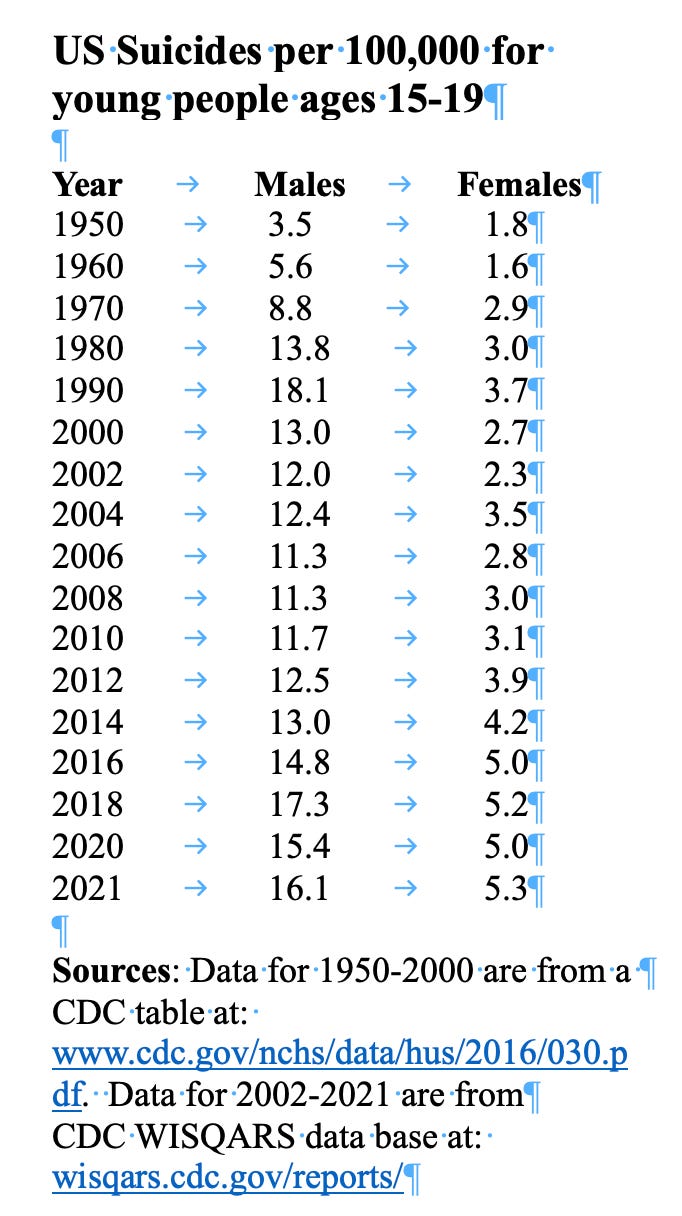D1. How Might We Explain the Huge Changes in Suicide Rates for Teens Over the Past 7 Decades?
This is an honest question. I present the data and ask for ideas.
This post is a digression from my sequence of letters about play. That is why I label it with a D, for digression. It is D1 because it is my first digression. I will post digressions when I am thinking about something that may be of interest to subscribers, especially when I think they might help me figure things out.
There has been much press about the rise in suicides among teens over the past few years. In order, quite literally, to get a picture of this rise, and to see how recent years compare with past decades, and to see how the rates differ between young males and young females, I compiled data for U.S. teen suicides from records kept by the Centers for Disease Control and Prevention (CDC) to create the table and graph below. The data are for young people age 15-19 because that is the standard grouping the CDC uses that comes closest to the high-school age range that interests me most.
[OK, I’ve revealed that I’m old-school here. I found it easier to create the graph by hand on graph paper than to figure out how to do it on Excel and get the X-axis distribution correct. For the actual numbers, see the table below.]
A number of things stand out in the graph.
First, regardless of year, the suicide rate is much higher for males than for females. It is often reported that females attempt suicide more often than males, but their methods are less deadly and are reversed by treatment. When a suicide attempt does not lead to death, however, it is hard to know if it was an actual attempt or a dramatic way of calling for help. Whatever the explanation, it is clear that, at least for the past 72 years, teen boys have killed themselves at far higher rates than teen girls.
The second dramatic thing to notice is the huge, almost linear increase in suicide rate for boys between 1950 and 1990. The rate per 100,000 individuals increased more than 5-fold, from 3.5 to 18.1. In contrast, the increase for females over these same years was just a shade over 2-fold, from 1.8 to 3.7.
The third dramatic thing to notice is the sharp drop in male suicides between 1990 and 2002 compared to a more modest decline for females over that 12-year span.
The fourth dramatic thing to notice is the male rate rose steeply again from 2010 to 2018. In fact, over this period it rose at about the same high rate as it had risen between 1970 and 1990, though it did not quite reach the 1990 peak. The rate for females also increased from 2010 to 2018, at a slope of increase steeper than in any period before that time, but the slope was still much less than that for males. [Parenthetically, I note that the dip in suicide rate in 2020 was most likely the result of the well-documented decline in teen suicides when schools closed for COVID. For more on that, see here.]
So, I have the following questions:
1. What was happening between 1950 and 1990 that caused a dramatic and essentially linear increase in suicides for teen boys and a much smaller increase for teen girls?
2. What was happening between 1990 and 2002 that caused a dramatic decline in suicides for teen boys and a much smaller decline for teen girls?
3. What was happening between 2010 and 2018 that caused a renewed dramatic increase in suicides for teen boys and a smaller but still substantial increase for teen girls?
These are real questions. I don’t know the answers. I’m asking in the hope that you might have some ideas you are willing to share in the comments below. What are your hypotheses? Feel free to speculate on the basis of anything you know about the time periods we are talking about that might possibly help answer these questions. If collectively we can come up with some plausible hypotheses I might, perhaps with help, be able to find some evidence to support or refute them.
These are really important questions for anyone who cares about teen mental health.
If you haven’t yet subscribed to this substack, I hope you will do so now, and if you know others who might be intrigued by these questions please share this with them so they can sign up and add to the comments.



I would be interested in any changes to how suicides are recorded in this time period. e.g. the further back you go, there was presumably more stigma around it and perhaps deaths by suicide were coded as something different?
There are lots of great ideas already in these comments. I have responded to a few of them, somewhat randomly, but will think about them more systematically in coming days and prepare a new D post summarizing some of them and presenting my own current hypotheses concerning the three questions. Keep the thoughts coming, and if anyone is interested in doing some research to test one or more of the hypotheses, let me know.